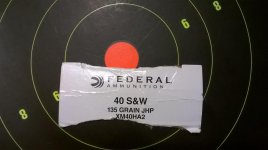Just to be sure I'm on the right page here, let me say I understand your concern to be increased pressure in 180gr 40 loads caused by bullet set back. I agree that this causes a dangerous condition, especially in a barrel with a partially unsupported chamber. But in my mind the issue is more the set back than any particular bullet/cartridge combination. I have actually seen more catastrophic case failures with 9mms than anything else, In those cases where I can be reasonably certain what happened, the cause was high cost defensive ammunition being cycled multiple times through the action before being fired. Of course in many cases I don't have a clue what happened, but I've seen enough to be cautious about set back in any cartridge.
One problem I have with the link you posted is the assumption that the shorter bullets will be more forgiving in a setback situation because thare will be greater case volume remaining. While that may be true it also may be rendered meaningless by the burning rate of the powder. And you have no way of knowing what power is used in commercial ammunition as it is a commodity purchased in bulk and blended on a lot to lot basis. So to my mind the trick is to avoid setback in the first place. I cycle auto pistol cartridges once. If it doesn't go out the barrel, it goes in the salvage box.
I guess I should make clear I'm talking about factory ammo here. When talking reloads there are a lot of other factors involved and we could talk for ever.
I don't expect my arguments to change your mind. If I has a gun come apart in my hand it would take a lot more than some guy's post on the Net to change my mind. But I do want to point out that shorter, lighter bullets may not provide as much margin of safety as one might think.
Regards

